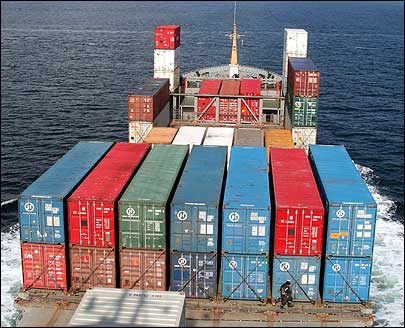Jan 25, 2008Siemens IT Solutions and Services has conducted a proof-of-technology test on RFID-based equipment that can be utilized to monitor shipping containers while they're at sea. The company says the test demonstrated the technology closes a gap found in commercially available cargo-monitoring RFID systems that provide RFID data only while on land.
"We have shown that it's now possible to continuously monitor containers—from the time they leave the harbor to their final destination," says Stefan von der Heide, head of the Mogis (Mobile GSM Infrastructure Over Satellite) solution at Siemens IT Solutions and Services.

Siemens IT Solutions and Services plans to repeat the test using additional tagged containers and a variety of satellite connections. The company is also considering a market launch of the cargo-tracking solution, but declines to disclose details since it's currently in negotiations with partners.
To develop the Mogis system, Siemens IT Solutions and Services teamed with Nokia Siemens Networks, which provided the solution's GSM telecommunications infrastructure, a smaller version of a cellular phone network. TriaGnoSys developed the satellite communications elements. The main application for Mogis is enabling GSM coverage where no such coverage exists, such as on ships at sea, at disaster sites or on airplanes. By adding RFID to the solution, however, the system was adapted for tracking containers on the high seas.
At-sea tracking is valuable for ensuring the safety of goods. "In case a temperature alarm is triggered out there on the sea," von der Heide says, "the end customer can be informed before the freight reaches the destination harbor [so the customer] can order a replacement."
Working with a group of mostly undisclosed partners, Siemens IT Solutions and Services performed the test in March. The solution features active RFID transponders and sensors. Data collected via RFID was transmitted over on-board GSM and GPRS telecommunications networks connected to a satellite telecommunications service operated by Inmarsat.
Each container's RFID tag transmitted its ID number and sensor data to an RFID reader, which then forwarded that information via a GSM base station to an on-board control system, and via satellite to the ground system monitored by a central surveillance center.
The information included messages about the status of the containers, such as temperatures and location (calculated via GPS). If a container was opened and the sensor indicated a drop or rise in temperature beyond acceptable levels, a system alarm sounded at the surveillance center.
"The surveillance center then informs the end customer," von der Heide says. "However, if the end customer is interested, the tracking box can send an alarm message directly to the end customer's mobile phone."
During the test, the partners faced poor satellite service due to bad weather and a lack of capacity on the satellite. Otherwise, von der Heide says, the system worked without fail.
A similar system was tested by the U.S. Department of Transportation's Transportation Security Agency (TSA) in 2003 (see U.S. Tests Satellite Security System).


